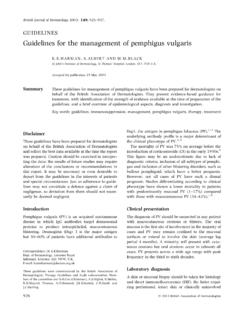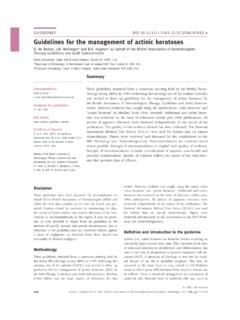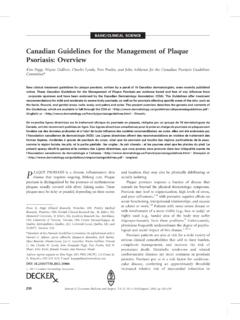Transcription of DRUG NAME: ANASTROZOLE
1 ANASTROZOLE drug name : ANASTROZOLE SYNONYM(S): IUPAC; ZD1033; ICI D1033 COMMON TRADE name (S): ARIMIDEX (notice of compliance,1 April 1997; patent expires2 October 2012) CLASSIFICATION: Aromatase inhibitor Special pediatric considerations are noted when applicable, otherwise adult provisions apply. MECHANISM OF ACTION: ANASTROZOLE is a reversible (Type II), nonsteroidal aromatase inhibitor. Aromatase catalyzes the final and rate-limiting step in the conversion of androgens to estrogens in peripheral tissues. This occurs mainly in adipose tissue, but also in normal and malignant breast tissues, and provides the main source of estrogen in postmenopausal women. The goal of hormone therapy in breast cancer is to deprive tumour cells of estrogens, which are implicated in the development or progression of ,4 Maximal estrogen suppression is produced by a 1mg Estrogen suppression is maintained for up to 6 days after discontinuing Differences in the mechanism of action may contribute to the apparent lack of cross-resistance between steroidal (eg, exemestane) and nonsteroidal (eg, ANASTROZOLE and letrozole) aromatase Highly selective blockade of aromatase does not interfere with the production of other steroids (eg, adrenal corticosteroids, aldosterone)6 or thyroid stimulating ANASTROZOLE does not have progestogenic, androgenic or estrogenic ,8 PHARMACOKINETICS.
2 Interpatient variability no information found Oral Absorption rapidly and almost completely absorbed9; food reduces absorption rate time to peak plasma concentration within 2 h steady-state plasma level is 3-4 times higher than the level after a single dose and achieved after 7-9 days of once daily oral dosing6 cross blood brain barrier? no information found volume of distribution no information found Distribution plasma protein binding 40% primarily in the liver via N-dealkylation, hydroxylation and glucuronidation active metabolite(s) none Metabolism inactive metabolite(s) triazole, glucuronides, hydroxy- ANASTROZOLE biliary and renal excretion biliary 85% urine 11% terminal half life 50 h (range, 30-60 h)
3 10 Excretion clearance no information found Gender no information found Elderly no clinically significant differences Children no information found Ethnicity no clinically significant differences in pharmacodynamics and pharmacokinetics between Asian and white postmenopausal women11 Adapted from reference 8 unless specified otherwise. BC Cancer Agency Cancer drug Manual Developed: 2001 Limited revision: 1 April, 2005 Page 1 of 7 ANASTROZOLE ANASTROZOLE USES: Primary uses: Breast cancer12-16 Heath Canada Therapeutic Products Programme approved indication No pediatric indications.
4 SPECIAL PRECAUTIONS: Carcinogenicity: No information Mutagenicity: Not mutagenic in Ames test and in mammalian in vitro mutation test. ANASTROZOLE is clastogenic in in vitro and in vivo chromosome Fertility: No information Pregnancy: FDA pregnancy category D17 There is positive evidence of human fetal risk, but the benefits from use in pregnant women may be acceptable despite the risk (eg, the drug is needed in a life-threatening situation or for a serious disease for which safer drugs cannot be used or are ineffective). Breastfeeding is not recommended due to potential secretion into breast SIDE EFFECTS: The table includes adverse events that presented during drug treatment but may not necessarily have a causal relationship with the drug . Because clinical trials are conducted under very specific conditions, the adverse event rates observed may not reflect the rates observed in clinical practice.
5 Adverse events are generally included if they were reported in more than 1% of patients in the product monograph or pivotal trials, and/or determined to be clinically ORGAN SITE SIDE EFFECT ONSET Clinically important side effects are in bold, italics I = immediate (onset in hours to days); E = early (days to weeks) D = delayed (weeks to months); L = late (months to years) hypertension (3-9%)19 E D ischemic cardiovascular disease (3-4%)20-22 L peripheral edema (8-10%) E thromboembolism (2-4%)20-22 D cardiovascular (general) vasodilatation (25-35%)19 E asthenia (16-18%) E fatigue/tiredness (19%)20-22 E sweating (2-4%)19 E constitutional symptoms weight gain (13%)14 D hair thinning (rare) E D dermatology/skin rash (6-10%)19 E D endocrine hot flashes (13-35%)20-22 I E emetogenic potential: nonemetogenic14 E anorexia (5-7%) E gastrointestinal constipation (9%) E D BC Cancer Agency Cancer drug Manual Developed.
6 2001 Limited revision: 1 April, 2005 Page 2 of 7 ANASTROZOLE ANASTROZOLE BC Cancer Agency Cancer drug Manual Developed: 2001 Limited revision: 1 April, 2005 Page 3 of 7 ANASTROZOLE ORGAN SITE SIDE EFFECT ONSET Clinically important side effects are in bold, italics I = immediate (onset in hours to days); E = early (days to weeks) D = delayed (weeks to months); L = late (months to years) diarrhea (8%) E D dry mouth (6%) E nausea (11-19%)20-22 I E vomiting (8-13%)20-22 I E hemorrhage vaginal bleeding (1-5%)20-22 E hepatic elevated liver function tests (infrequent)18 D lymphatics lymphoedema (9%)19 D metabolic/laboratory hypercholesterolemia (7%)19 L arthritis (14%)19,23 L arthrosis (6%)23 E fractures (6-11%)19-22 L hypertonia (3%) E musculoskeletal osteoporosis (7%)22,23 L anxiety (5%)19 D depression (5-11%)19 D dizziness (6%) E insomnia (6-9%)19 E ischemic cerebrovascular events (1-2%)
7 20-22 L neurology neuropathy, sensory (5%) E ocular/visual cataracts (4-6%)20-22 L abdominal pain (8%) E arthralgia/myalgia (5-36%)19,22-24 E back pain (10-12%) E D bone pain (5-11%)23 E D breast tenderness (7%)19 E D chest pain (5-7%) E headache (9-14%) E pain pelvic pain (5%) E D cough (8-11%) E D dyspnea (10%) E D pulmonary pharyngitis (6-12%)19 E vaginal discharge (2-3%)20-22 E renal/genitourinary vulvovaginitis (6%)19 E vaginal bleeding (see under hemorrhage ) E sexual/reproductive function vaginal dryness (3%) E flu-like symptoms (7%) E syndromes tumour flare (3%) E ANASTROZOLE Adapted from reference 8 unless specified otherwise.
8 INTERACTIONS: AGENT EFFECT MECHANISM MANAGEMENT antipyrine no significant effects on antipyrine pharmacokinetics cimetidine no significant effects on ANASTROZOLE pharmacokinetics estrogen (estrogen replacement therapy, Premarin, , Estracomb, Estraderm) may interfere with therapeutic effect of ANASTROZOLE estrogen can counter the estrogen suppression effect of ANASTROZOLE see below warfarin no significant effects on warfarin pharmacokinetics and pharmacodynamics tamoxifen25 no significant effects on tamoxifen pharmacokinetics; tamoxifen does not appear to affect estrogen suppressant effect of ANASTROZOLE Adapted from reference 19 unless specified otherwise. ANASTROZOLE is a weak inhibitor of cytochrome P450 in vitro and not expected to have clinically significant interactions with drugs metabolized by cytochrome Estrogen use with ANASTROZOLE : use other options for conditions in which estrogen is indicated.
9 If estrogen is used, prescribe the lowest dose to relieve symptoms, monitor patient carefully and consider short term For vaginal complaints such as dyspareunia, dryness and sexual dysfunction, topical estrogen may be considered. Estring produces a local effect with systemic levels measurable only for the first 24 hours of the three month ring. Premarin cream can be used but may have variable systemic levels related to the absorption through the vaginal tissues. The lowest dose to relieve symptoms should be SUPPLY AND STORAGE: Tablet: 1 mg; inactive ingredient includes lactose. Store at room DOSAGE GUIDELINES: Refer to protocol by which patient is being treated. Adults: BCCA usual dose noted in bold, italics Oral: 1 mg PO once daily. Administer with food or on empty Dosage in renal failure: no adjustment required8 Dosage in hepatic failure: No dose adjustment is required in mild to moderate hepatic dysfunction.
10 Dosing studies have not been done in patients with severe hepatic BC Cancer Agency Cancer drug Manual Developed: 2001 Limited revision: 1 April, 2005 Page 4 of 7 ANASTROZOLE ANASTROZOLE BC Cancer Agency Cancer drug Manual Developed: 2001 Limited revision: 1 April, 2005 Page 5 of 7 ANASTROZOLE BCCA usual dose noted in bold, italics Dosage in dialysis: no information found REFERENCES: 1. Health Canada Therapeutic Products Programme. Notices of compliance (NOC)-Drugs. Available at: Accessed August 30, 2000. 2. Health Canada Therapeutic Products Programme. Patent register. Available at: Accessed August 30, 2000. 3. Njar VC, Brodie AM. Comprehensive pharmacology and clinical efficacy of aromatase inhibitors.












